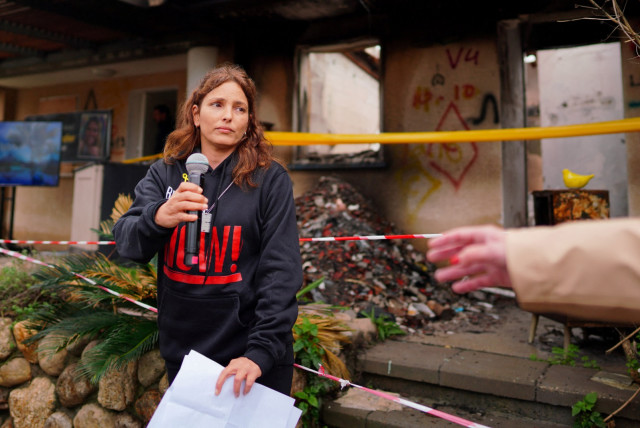Bringing border communities home amid continuing rocket threats - analysis

Post-Passover, rocket attacks near Gaza and Lebanon raise questions on border community safety. Evacuations prompt reevaluation of defensive strategies and military presence.
The radio news bulletin as the Passover holiday ended Monday evening sounded sadly familiar and, unfortunately, very similar to what the nation was accustomed to prior to October 7.
No, it wasn’t because of protests in Tel Aviv and Jerusalem. Rather, it was the reports of sirens warning of incoming rockets in communities near the Gaza border. One rocket was intercepted over Sderot, and two fell in the sea off of Ashdod.
Nearly seven months into the Gaza war, terrorists from the coastal strip still have the ability to send residents of nearby towns scurrying for cover, and two people in Sderot were hurt doing just that.
The frequency of the attacks and the number of rockets fired have declined dramatically since the war began, but Hamas’s ability to fire off rockets still exists.
Likewise, Hezbollah and Hamas fired dozens of rockets from Lebanon into communities near Israel’s northern border during the Passover holiday, with anti-tank missiles damaging six homes in Metulla.
Those reports bring into focus a major question that the government needs to grapple with as talks progress on a possible ceasefire as part of a hostage release deal: What will it take to enable the tens of thousands of residents in towns and communities along the Lebanese and Gaza borders to return home?
Assume for a second that there is a ceasefire of some six weeks, and as a result, Hezbollah and Hamas stop their rocket fire in the North. In such a scenario, should residents of the communities there be allowed to return to their homes?
And even if they are allowed to return, will they?
What will it take for residents of the North and South who were evacuated to feel safe enough to return home? Will it take a complete end to all rockets from both arenas to enable people to return to their homes? Is that even a realistic expectation?
When the government ordered the evacuation of communities in significant swaths of the country just after the start of the war, it set a dangerous precedent. It is understandable why the decision was taken, but it still set a dangerous precedent by showing the enemy they could chase people away from their homes.
That decision, however, was born of a security doctrine that has since collapsed: that Israel can turn a blind eye to an enemy building up directly on the border, believing that the enemy, fearing a furious Israeli response, would not do anything “crazy,” such as using the significant capabilities that they built up.
As such, Israel did not act following the Second Lebanon War in 2006, when Hezbollah violated the US Security Council Resolution and built up a missile arsenal with Iran’s help that would do a small NATO country proud.
Israel saw the buildup there, as well as the stationing of Hezbollah units directly on the border trained to infiltrate Israeli communities, but in its two-decade-old sanctification of quiet, it did not want to take action, fearing that would lead to a wider conflagration it did not want and believing that Hezbollah would be deterred by Israel’s might.
The same was true in Gaza. Israel saw the tremendous buildup of weapons and military capabilities inside Gaza, but only took limited action, believing that the knowledge of Israel’s superior might and suitcases of Qatari money could deter Hamas.
Neither in Lebanon nor in Gaza did Israel act against the buildup it was witnessing. As a result, when Hamas attacked on October 7 and there was a fear that Hezbollah would follow suit on October 8, Israel had little choice but to evacuate civilians because they were very much in the direct line of fire.
In Lebanon, Hezbollah was stationed right on the border, within spitting distance of Israeli communities, just as Hamas was in Gaza. Had Israel prevented the buildup in Lebanon over the years, it would not have had to evacuate those communities because Hezbollah would not have been able to fire directly into border communities with anti-tank missiles.
The unprecedented evacuation of these communities – something that went against the ethos this country was built upon – was a result of relying for the last two decades on state-of-the-art walls and fences and technological bells and whistles to defend the country’s residents rather than on active defense, such as taking military action to prevent a threatening military buildup.
It is safe to assume that this doctrine will now be buried and Israel will go back to taking offensive action to prevent threats rather than just building up defensive fortifications to protect itself from those threats.
But in the meantime, the question remains:
What will make the residents of the Gaza and Lebanese border communities feel safe enough to return home?
One element will be the massive redeployment of IDF soldiers to these borders. The presence of thousands of soldiers will not only give residents a sense of security, but will also provide real-time response possibilities if there is a massive incursion across or underneath either of these borders, as there was on October 7.
The second element will be a combination of responding immediately and with great force to every rocket fired or even every inflammable balloon launched, even if they are intercepted or land harmlessly in the sea, and taking preemptive action against seemingly small threats, such as the deployment of Hezbollah’s Redwan force right on the border fence with Israel, before they metastasize into something much worse.
Jerusalem Post Store
`; document.getElementById("linkPremium").innerHTML = cont; var divWithLink = document.getElementById("premium-link"); if (divWithLink !== null && divWithLink !== 'undefined') { divWithLink.style.border = "solid 1px #cb0f3e"; divWithLink.style.textAlign = "center"; divWithLink.style.marginBottom = "15px"; divWithLink.style.marginTop = "15px"; divWithLink.style.width = "100%"; divWithLink.style.backgroundColor = "#122952"; divWithLink.style.color = "#ffffff"; divWithLink.style.lineHeight = "1.5"; } } (function (v, i) { });

